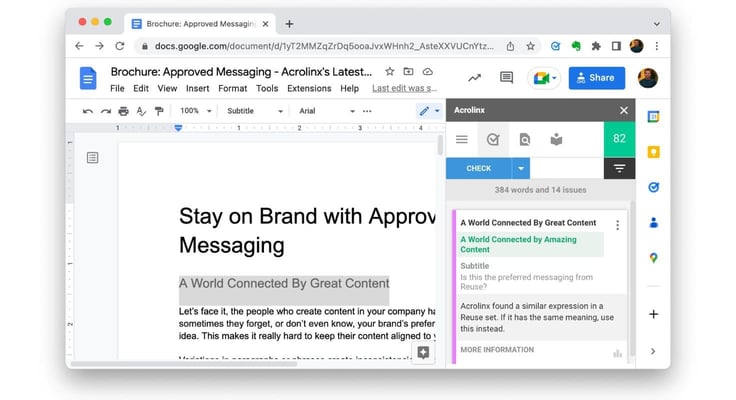
TL; DR: AI has been shown to have risks in content, especially for companies with an ample supply of content sources and insufficient management of the editorial process. But what if businesses could leverage AI to improve content governance? Acrolinx helps companies govern their content sources efficiently with its AI editorial management software. It allows users to train language models with their best content and create brand-specific guidelines for every content form, from technical documentation to marketing blogs. We spoke with Christopher Willis, Chief Marketing Officer of Acrolinx, about how Acrolinx enables companies to maintain their content strategies, create brand-aligned content, and optimize the editorial process for cost and time savings.
Content has been one of the primary subjects at the center of the debate that is generative AI. While some companies turned to AI tools to increase their content output and productivity, others saw it as a threatening force that would soon take over human jobs. But what if there were a happy middle to this debate?
Both sides have their advantages but also their drawbacks. Leveraging AI for content production has its risks. Several companies have been burned by the perils of generative AI, which include false content production and AI hallucinations — a phenomenon where AI misinterprets prompts and invents outputs that don’t match accurate data. But businesses can also miss out on some valuable benefits by ignoring AI capabilities.

Acrolinx introduces a different approach — one that combines the valuable creativity of humans with the reliable and mechanical attributes of AI. Its editorial management system allows companies to write consistent and clear content that is always on par with their editorial and brand guidelines, whether the written product is an email newsletter or a technical how-to.
“Generative AI is helping companies make more content, but not better content. Our software, however, consumes your best content and from that creates tone of voice, terminology, and clarity models for you to tweak,” said Christopher Willis, Chief Marketing Officer of Acrolinx.
For Acrolinx, it’s not about increasing content output but improving the overall efficiency of content at every stage of the writing process. Its software allows companies to build consistent style guides and ensure their brand voice remains clear across channels. All of its generative AI models are trained on the customer’s individual content repository, ensuring customer standards are met.
Boosting the Efficiency of Content Strategies
Maximizing content creation shouldn’t be the end-all,be-all. This is evident in the concerns of major newsrooms across the country. Using generative AI to boost content generation has led to businesses publishing misleading content, which has affected their credibility and audience trust.
The Acrolinx team wants to help users leverage generative AI the right way. As it happens, Acrolinx has more than 20 years in the business of content optimization and AI. “Acrolinx was really the trailblazer in this space of content optimization. It was always more than spellcheck. It was the character of the content, the tone of voice, clarity, consistencies, and terminology. So that companies could write for the brand across many writers,” said Christopher.

Companies juggle several content formats, including blogging, marketing copy, and documentation, and have different writers for each. So, it can be challenging to maintain a consistent content strategy across these forms. Acrolinx’s editorial management system enables businesses to establish a definitive editorial presence for all these writing processes.
“There is no one source of content creation. So we pull all of this content in, capture it, and align it. It’s reducing risk associated with not only the creation process but problematic content in general, such as wrong terminology, inclusive language issues, false content, and so on,” said Christopher.
Acrolinx serves as an editorial manager for businesses to improve content quality and efficiency. By taking in a company’s best-written work, its system can then provide specific brand guidelines for every content form and help guide writers through their creation process. Acrolinx also tackles post-publication and compares performance metrics to define best practices.
“Companies can now tune models based on what is objectively their best content. All of this is designed to increase the business impact of everything they write. We’re creating this content for the purpose of engagement,” said Christopher.
Feeding AI Models with Company-Specific Guidelines
Content represents a brand and, in many cases, is the public’s first impression of a company. That’s why it is so important for businesses to have trustworthy and authentic brand voice and content. And to build that trust with customers, businesses must have consistency in their content delivery.
Starting with the creation process, Acrolinx helps companies establish clear guidelines for writers to follow and provides suggestions to improve quality. Christopher told us that Acrolinx has users with up to 30 different sets of guidelines to create content. So Acrolinx’s AI models can apply those guidelines and ensure writers are following the specific style based on the content type.
“Our product will take the busy work out of the editing process. So we’ll deal with all the correctness, grammar, clarity, and terminology issues so that you can read it and identify whether or not it says what you want to say,” said Christopher.
Acrolinx has also simplified the review process. Not only does it alert users about content issues, but it also pinpoints the parts that are inconsistent with the language model. So the editor doesn’t have to read through pages of content to understand there’s a problem.
“You can’t just throw content out in the world because it matters too much. So Acrolinx can check and find those problematic issues to help you chip away at the process and get a higher efficiency rate,” said Christopher.
Eliminating Mechanical Work for Humans
Acrolinx has helped companies build better content experiences faster with its content optimization and quality control capabilities. It has leveraged AI to allow humans to enhance how they work and prioritize what they do best — provide value in creativity. The Acrolinx team mainly works with technology, financial services, and pharmaceutical sectors to help them navigate the complexity of their content.
“For technical topics, It matters how they communicate because good technical documentation creates user adoption. For financial services and pharmaceuticals, it is the criticality of content. What we’re able to do is help companies comply with those compliance requirements and regulations,” said Christopher.
Acrolinx has helped companies, including Microsoft and Citibank, to infuse automation into their editorial processes and accelerate their time to publication. By doing so, users have also saved on costs. The Acrolinx team continues to look for new ways to develop its software and make content workflows smoother.
The security of its language models is the utmost priority when creating new features. But the team is also thinking about adding new features to increase efficiency, which involves improving any one of the editorial process’s steps.
“Our general pathway is to continue to greater efficiency. From there, you’re gaining risk reduction in content, brand alignment and value, and impact of content. You also gain the ability to govern all of the content in your organization and know what you have, how you want to use it, and where it goes in the future,” said Christopher.


